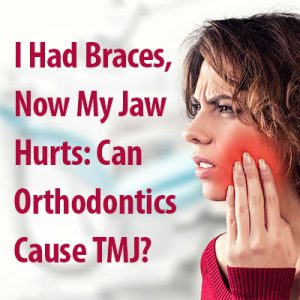I Had Braces, Now My Jaw Hurts: Can Orthodontics Cause TMJ?
 You had braces when you were younger and never experienced any jaw pain or other TMJ symptoms prior. Then, after you completed your orthodontic treatment, you developed a pain in your jaw, maybe accompanied by popping, locking, clenching and grinding. Maybe you developed these symptoms shortly after having your braces removed, maybe it was a decade later. Either way, could these two things be related?
You had braces when you were younger and never experienced any jaw pain or other TMJ symptoms prior. Then, after you completed your orthodontic treatment, you developed a pain in your jaw, maybe accompanied by popping, locking, clenching and grinding. Maybe you developed these symptoms shortly after having your braces removed, maybe it was a decade later. Either way, could these two things be related?
What is TMJ?
First, let us explain a little bit about TMJ—what it is, what causes it, and how it’s treated. TMJ stands for the temporomandibular joint, or the jaw joint. TMD stands for temporomandibular joint dysfunction and is used to describe any condition affecting the jaw joint—but TMJ is often used to describe the dysfunction as well.
Your TMJ is a complex structure made up of muscles, tendons, ligaments, cartilage, bones, lubricating systems, and shock-absorbing discs—all of which are subject to strain, sprain, and injury just like your other joints like your knees and shoulders. There are many factors that may contribute to TMJ dysfunction, including stress, injuries, habitual behaviors, as well as tooth alignment and bite problems.
There are many treatment options for TMJ, including:
- Awareness and gentle massage and stretching techniques
- Habit-correcting appliances like mouthguards or nightguards that minimize clenching and grinding
- Orthodontics to correct the alignment and bite
- Corrective jaw surgery for more severe cases
Orthodontics for TMJ Treatment
If your primary concern is not your tooth alignment, but your TMJ pain, it’s likely you will seek out a doctor who understands the delicate balance of the jaw joint and your alignment and bite. This may be a highly-trained general dentist, orthodontist, or a TMJ specialist.
Used strategically, orthodontics can help bring your teeth and bite into a healthier alignment to relieve tension that’s causing your TMJ. But if orthodontics is often used to treat TMJ, how could it also be a cause of TMJ?
Disrupting the Balance
Most orthodontic treatments are only meant to straighten teeth, especially if there were no pre-existing TMJ problems, and unfortunately, some orthodontists and general dentists providing orthodontic services are not well-trained in the relationship between the alignment, bite, and TMJ. So they slap some braces on you and straighten your smile so it looks beautiful, with little to no regard to how these changes may have disrupted the balance of your natural bite and jaw joint.
The Takeaway
The short answer to the question, “Can orthodontics cause TMJ?” is yes, sometimes—but it can help treat TMJ as well! TMJ dysfunction is complex and may be the result of multiple factors, not just orthodontics alone—especially if you developed symptoms many years after completing orthodontic treatment.
The most important thing to remember if you had braces in the past and now you’re suffering from TMJ is to choose a dentist, orthodontist, or TMJ specialist that is well-trained in treating TMJ disorders if you choose to seek treatment. If you’re considering braces for the first time and concerned about developing TMJ dysfunction, be sure to choose a dentist or orthodontist that understands the delicate balance of tooth alignment, bite, and the TMJ, and express your concern with your doctor.
Dr. Chad Johnson is one of these qualified professionals who understand these complexities and is highly experienced in treating both malocclusion and TMJ. If you have any questions about orthodontics and TMJ, or you’d like to come to see us in person, contact your Pleasant Hill dentist at Veranda Dentistry today!
The content of this blog is not intended to be a substitute for professional medical advice, diagnosis, or treatment. Always seek the advice of qualified health providers with questions you may have regarding medical conditions.










